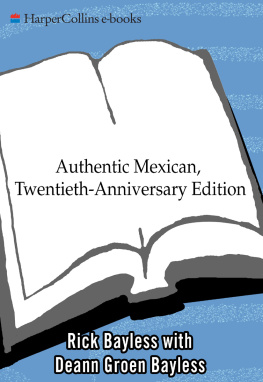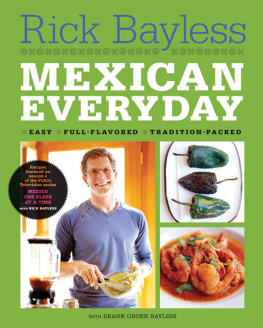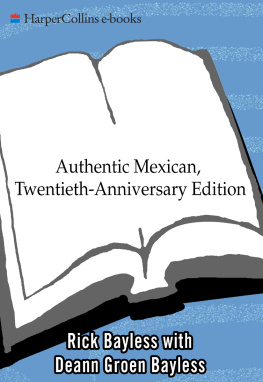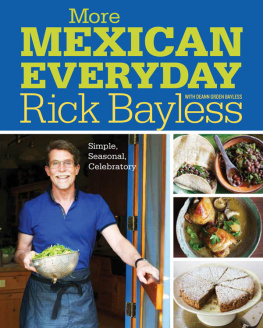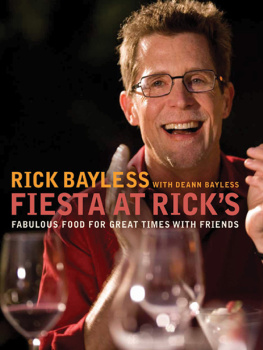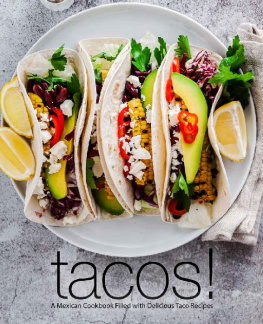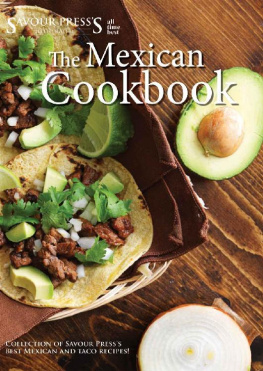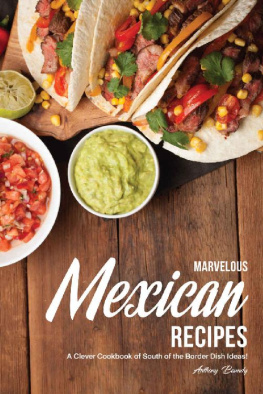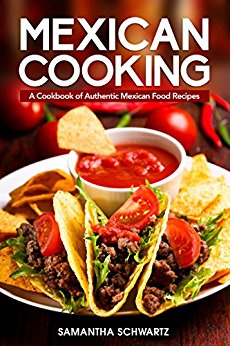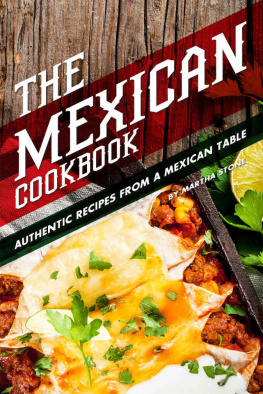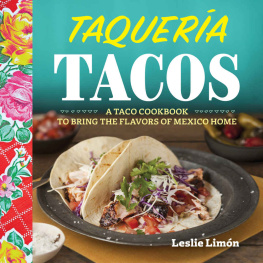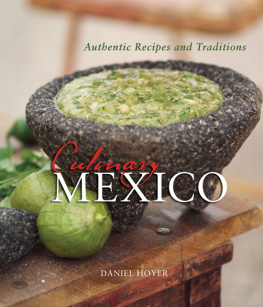Authentic Mexican
Regional Cooking from the Heart of Mexico
Twentieth-Anniversary Edition
Rick Bayless with Deann Groen Bayless
Illustrations by John Sandford
Photographs by Christopher Hirsheimer


Cooks mask with hinged mouth
To the memory of Gladys Augusta Potter, my grandmother,
who taught me that you can bring a lot more than food
to the dinner table
Contents
I n the mid-eighties, when my wife, Deann, and I were living in Mexicotraveling through every one of that countrys thirty-one states, exploring age-old markets, working with local cooks to learn the dishes that had stood the test of timeI knew just what kind of cookbook was in the making. I was crafting firsthand reports of who was cooking what in Mexico, and exactly where they were doing it. I was amassing historical, geographical and social context for Mexicos regional cooking. And I was capturing vivid verbal snapshots of authentic ingredients and traditional techniques that seemed to be getting nudged out as more shoppers (yes, even in Mexico) opted for the less diverse packaged stuff at mega-stores like Aurrer and Wal-Mart.
Clearly, I was writing a cookbook for Americans who would describe themselves as adventurous and dedicated cooksdefinite fans of Mexican food. And I assumed (or at least hoped) that they had traveled (or hoped to travel) through Mexico, and had a hankering for the non-Americanized real thing. That didnt mean, however, that this motivated group wouldnt end up bewildered as they sorted through the great variety of Mexicos regional dishes and ingredients.
What those adventurous, dedicated souls needed, I resolved, was a cookbook that clearly explained the steps to traditional flavor within the context of both their American kitchens and the native kitchens of those who had created the traditions. Having lived for several years in Mexico after finishing an undergraduate degree in Spanish language and literature, followed by graduate studies in linguistics and anthropology, I was offering to become their guide and translator.
Little did I know how food and culture would evolve in the United States over the next twenty years. Hispanics, the majority of them Mexican, have become the fastest-growing immigrant group in North America. Which means two things: most non-Hispanic Americans dont have to travel south of the border to encounter a taste of real Mexico (there are authentic grocery stores and ma-and-pa restaurants catering to Mexicans popping up as fast as Starbucks), and once-rare ingredients like chipotle chiles, tomatillos and key limes are now available in American grocery stores. So easily available, in fact, that theyve started taking on a new life in the American kitchen, flavoring everything from barbecue sauces to chutneys to salad dressings. Dulce de leche (aka cajeta in Mexico) has become one of the most popular Hagen-Dazs ice cream flavors. Salsa, as weve heard repeatedly from the news media, is outselling ketchup.
Regional Mexican ingredients are even available in fresher and more convenient forms. When I was writing Authentic Mexican , tinny-tasting canned tomatillos were all most Americans could find; now citrus-bright fresh tomatillos are our norm. Back then, cilantro was called Chinese parsley, and those lustrous dark-green poblanos claimed almost no real estate in our countrys produce departments. Smoky, spicy dried chipotle chiles used to be an American cooks dream; nowadays a quick search in practically any U.S. town will produce chipotles in a variety of forms: dried (both the tan and the red varieties), powdered, canned in adobo , even pickled. Cactus paddles, if you were lucky to stumble upon them twenty years ago, were slimy, pickly strips in a dusty jar; just yesterday I bought beautifully fresh paddles for grilling at my local natural-foods grocery. Recently, when I discovered that a national retailer had started canning roasted tomatoesroasting tomatoes is a technique traditional Mexican cooks use to add sweetness and depthI knew that traditional Mexican food had taken on a more expanded role in the American kitchen.
In short, the food of Mexico has started to shed its exotic, ethnic character and is moving right toward the mainstream. Even Mexican-American food (Tex-Mex, Cal-Mex, New-Mex or whatever regional variation seems appropriate) is evolving, trading in its cheese-covered heaviness for a fresher, lighter approach that characterizes much of the food thats eaten south of the border.
Yet all of this accessibility of ingredients and growing familiarity with Mexican cuisine hasnt eliminated the need for a good set of classic recipes. Thats why Ilike so many of youcontinue to turn to Authentic Mexican for a really great tortilla soup or fresh corn-poblano chowder, for a soul-satisfying pork tinga or Yucatecan shrimp a la vinagreta , for street-style red chile enchiladas or that savory, fruity Oaxacan mole they call manchamanteles . The recipes I mined over many years from hundreds of Mexicos traditional cooksand perfected in my American kitchenhave never let me down.
A great number of people are responsible for the creation of this book: My mother and stepfather, Levita and Andy Anderson, and Deanns mother, Edith Groen, who provided generous support, both emotional and financial. The scores of Mexican cooks in markets, street stalls, small restaurants and homes, who shared both the details of their craft and a love for their specialties. Employees of the tourism offices all over Mexico, who went out of their way to supply information on local specialties and where to find them. The people running the gastronomical library at the offices of the Loredo restaurant group in Mexico City, who offered unlimited access to their collection of regional Mexican cookbooks. Cliff and Sue Small, who generously opened their Mexican home to us and introduced us to rural Mexican life. Carol Zylstra, Virginia Embrey and Maria Villalobos (and her mother), who shared their love for Mexican life, knowledge of little-known places and (in the case of Maria and her mother) delicious recipes. Fran and Jim Murray of Murray Western Foods in Los Angeles, who unflaggingly supported us through the years, and Peggy Playan, who was always encouraging and gracious in spite of our erratic consulting schedule. Craig Sumers and Brad Friedlander of Lopez y Gonzalez restaurant in Cleveland, who believed that regional Mexican dishes were not only very tasty but could attract an enthusiastic clientele. Many friends and family (especially Georgia and Dan Gooch, Floyd and Bonnie Groen, Paul and Macky Groen, Jewel and Bob Hoogstoel, Bill and Yvonne Lockwood, Jan and Dan Longone, Margot Michael, Nancy and Gary Oliver, Mary Jane and Steve Olsen, Pep and Ilene Peterson and Peg Tappe), who contributed valuable knowledge, encouragement and recipe-testing skills. LuAnn Bayless, my sister, who freely devoted a good portion of one summer to testing recipes with us, and Molly Finn, who tested recipes in New York. Maria Guarnaschelli, my editor, who saw value in my research and worked enthusiastically to give it a beautiful, easily usable form. Amy Edelman, my copy editor, who scrutinized all the details with amazing rigor, unearthing lost ingredients and taming wayward punctuation. Molly Friedrich, my hardworking agent, who gives sound advice. And finally, John Sandford, whose kindness and sensitivity have made him a treasured friend and whose brilliant illustrations lovingly celebrate regional cooking from the heart of Mexico. My respect and thanks to you all.

